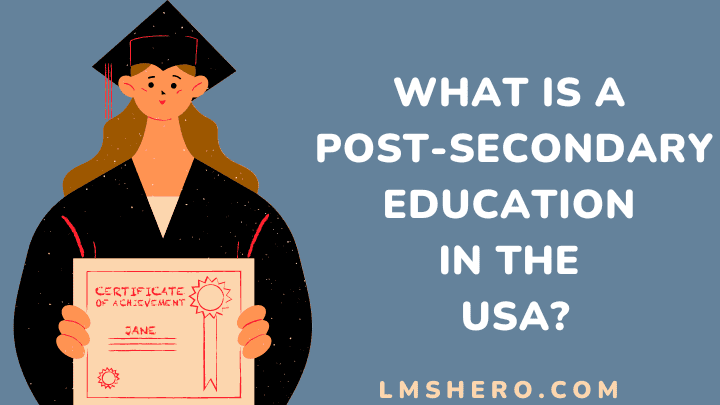Higher education has become an important part of many people’s lives. It gives people the opportunity to gain knowledge and skills to help them in their careers and lives. Hence, many people feel excited and ready to begin their post-secondary education journey.
This is great news because it means plenty of options for students to get the education they need to succeed in today’s economy. However, post-secondary education in the USA is also a major challenge.
In this article, you’ll learn more about post-secondary education, the challenges, the types of post-secondary education available, and some of the benefits of pursuing a degree.
Let’s get started.
What is a post-secondary education?
Higher education has long been the key to success in the United States. It allows students to pursue their dreams, connect with others, and gain valuable knowledge and skills.
And thanks to post-secondary education offered by colleges and universities, millions of people have achieved their goals.
Post-secondary education (also known as tertiary education) is a type of schooling that typically happens after high school. It offers specialized training in a variety of subjects, as well as opportunities for on-the-job experience.
Post-secondary education provides students with the skills and knowledge necessary to pursue a career or further their education.
Many post-secondary institutions offer a variety of courses and programs that can help students find a path in life.
What are the major benefits of post-secondary education in the USA?
Post-secondary education in the USA is one of the best investments you can make in your future.
Post-secondary education has many benefits, whether a 4-year degree, a 2-year diploma, or a trade school program. Here are just some of them:
- A chance to learn and grow in an environment that stimulates and supports your intellectual growth
- Develop strong personal relationships with your peers, professors, and mentors
- The opportunity to gain lifelong learning and knowledge will be valuable in any field
- A chance to explore different disciplines and learn new ways of thinking
- Accessing world-class resources can help you achieve your academic and career goals
- A degree from a top university boosts your career prospects and imparts intangible skills and knowledge that are valuable in the workplace
The USA has one of the best post-secondary education in the world. Not only is it a diverse country in terms of colleges and universities, but the quality of education here is unparalleled.
MPI reports that almost 1.1 million post-secondary education international students were studying in the USA during the 2019-2020 academic year.
The United States offers a unique opportunity for students to explore their interests and learn from some of the world’s top educators.
Differences between a secondary and post-secondary education
There are many differences between secondary and post-secondary education. For one, a post-secondary education consists of a four-year degree, while a secondary school consists of grades 6-12 in the USA.
Post-secondary education is typically geared toward students who have graduated from high school. In contrast, a secondary school may have students who eventually graduate from high school and others who will not.
In addition, secondary schools are more lenient with what they expect their students to be able to do. On the other hand, post-secondary institutions require more rigorous courses and assessments throughout the program.
Types of post-secondary education in the USA

1. Colleges and universities
In the United States, post-secondary education is any type of education a student takes after high school. A college or university is often the most common type of post-secondary institution.
To attend, you must apply and be accepted to the school you want to attend before enrolling. You’ll need to fill out an application form and pay a fee.
Colleges and universities offer many different types of programs for students to choose from. A college usually offers certificate and diploma programs. Colleges generally have a more direct career focus when comparing college programs to university programs.
Universities may be either public or private institutions, with major research capabilities, and often focus on graduate study at the doctoral level or beyond.
2. Community colleges
The community college (or junior college) is a public institution that offers two-year associate degree programs. Additionally, they offer vocational and technical programs.
Students at community colleges can earn a diploma in half the time since they only have to complete the general education requirements that colleges require.
Furthermore, community colleges offer students a wide range of courses and are typically less expensive than most universities.
This type of education is ideal for anyone who wants to start with something more affordable and flexible before committing to a major in school or at work.
3. Vocational or technical schools
Vocational and technical schools offer programs in various industries, including healthcare, business management, education, and culinary arts.
These programs are designed to provide hands-on training and skills that can be put to use immediately after graduation.
Vocation schools also offer instruction in automotive technology, HVAC installation, plumbing, and electrician training.
Students who want to learn from some of the best instructors in their field are well advised to enroll in this type of post-secondary education.
Challenges of post-secondary education in the USA
In the United States, post-secondary education is often the key to success. But despite the ever-growing cost of tuition, only some can afford college.
It’s no secret that the cost of post-secondary education in America is extraordinarily high. Tuition ranges from $4,000 to $32,000 for public universities and over $50,000 for private universities.
Many students struggle to independently cover tuition, room and board, textbooks, and other expenses. And even if they manage to do so, many are still left with a mountain of debt they must repay throughout their lifetime.
Fortunately, there are ways to help reduce the burden of tuition costs. First, financial aid options available to students may make it possible for them to attend college without worrying about debt.
Furthermore, many colleges and universities offer scholarships and grants that can help defray tuition costs. And finally, it may be a good idea to take up some part-time jobs.
FAQs
Are graduate programs post-secondary education?
Yes, graduate programs are post-secondary education.
Are there free universities in the USA?
There are free universities in the United States. Many colleges and universities offer a few programs for free, or at low cost, to those who qualify. Examples of such universities are Alice Lloyd College, City University of New York, and Berea College, among others.
Is post-secondary education in the USA worth it?
Yes, it is worth it. The right education will help you realize your career goals and prepare you for future success.
Is there a difference between university and college?
The main difference between a university and a college is that a university provides a broader academic and professional education, while a college offers specialized career or technical education.
Final thoughts
The post-secondary education system in the United States is diverse, with a range of prices and quality. However, there are some key things that all students need to know to make an informed decision about their post-secondary path.
First and foremost, post-secondary education is a valuable investment – not only for your career prospects but also for your intellectual development.
Furthermore, paying for quality post-secondary education is worth it – regardless of the school you choose.
You can find many resources available online to assist you in finding the right school and navigating the admissions process.
This is true whether you’re looking for scholarships or university rankings or looking for personal recommendations from students. Read the article on prospective students for more information.
You can also read more on the definition and benefits of secondary schools.
Thanks for reading.







